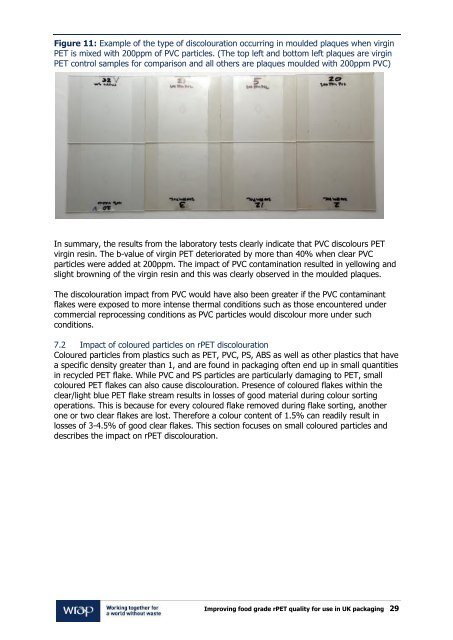rPET Quality Report
You also want an ePaper? Increase the reach of your titles
YUMPU automatically turns print PDFs into web optimized ePapers that Google loves.
Figure 11: Example of the type of discolouration occurring in moulded plaques when virgin<br />
PET is mixed with 200ppm of PVC particles. (The top left and bottom left plaques are virgin<br />
PET control samples for comparison and all others are plaques moulded with 200ppm PVC)<br />
In summary, the results from the laboratory tests clearly indicate that PVC discolours PET<br />
virgin resin. The b-value of virgin PET deteriorated by more than 40% when clear PVC<br />
particles were added at 200ppm. The impact of PVC contamination resulted in yellowing and<br />
slight browning of the virgin resin and this was clearly observed in the moulded plaques.<br />
The discolouration impact from PVC would have also been greater if the PVC contaminant<br />
flakes were exposed to more intense thermal conditions such as those encountered under<br />
commercial reprocessing conditions as PVC particles would discolour more under such<br />
conditions.<br />
7.2 Impact of coloured particles on <strong>rPET</strong> discolouration<br />
Coloured particles from plastics such as PET, PVC, PS, ABS as well as other plastics that have<br />
a specific density greater than 1, and are found in packaging often end up in small quantities<br />
in recycled PET flake. While PVC and PS particles are particularly damaging to PET, small<br />
coloured PET flakes can also cause discolouration. Presence of coloured flakes within the<br />
clear/light blue PET flake stream results in losses of good material during colour sorting<br />
operations. This is because for every coloured flake removed during flake sorting, another<br />
one or two clear flakes are lost. Therefore a colour content of 1.5% can readily result in<br />
losses of 3-4.5% of good clear flakes. This section focuses on small coloured particles and<br />
describes the impact on <strong>rPET</strong> discolouration.<br />
Improving food grade <strong>rPET</strong> quality for use in UK packaging 29



